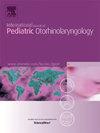扁桃体囊内手术与囊外手术:澳大拉西亚地区术后出血结果比较。
IF 1.2
4区 医学
Q3 OTORHINOLARYNGOLOGY
International journal of pediatric otorhinolaryngology
Pub Date : 2024-11-01
DOI:10.1016/j.ijporl.2024.112147
引用次数: 0
摘要
目的研究囊内(ICT)和囊外扁桃体切除术(ECT)术后出血的发生率和时间,并评估影响出血风险和严重程度的因素:方法:对澳大利亚和新西兰耳鼻喉科5年来的扁桃体切除术患者进行回顾性研究。主要结果是扁桃体切除术后大出血的发生率和时间:本研究共纳入了 12,275 名患者。扁桃体切除术后总出血率为 3.3%,其中 0.65% 需要返回手术室。ICT 的出血率为 1.7%,明显低于 ECT 的 4.1%(P 结论:ICT 能明显降低扁桃体切除术后出血率:与 ECT 相比,ICT 术后出血率和手术干预需求明显降低。这在有睡眠呼吸障碍的儿科患者中最为明显。对于某些患者群体,尤其是患有睡眠呼吸障碍的年幼儿童,信息和通信技术可能被认为是一种更可取的选择,尽管还需要更多证据来证实其对复发性扁桃体炎患者的有效性和安全性。本文章由计算机程序翻译,如有差异,请以英文原文为准。
Intracapsular versus extracapsular tonsil surgery: Comparison of postoperative haemorrhage outcomes in the Australasian setting
Objective
To investigate the incidence and timing of postoperative haemorrhage between intracapsular (ICT) and extracapsular tonsillectomy (ECT) techniques and evaluate factors influencing haemorrhage risk and severity.
Methods
A retrospective review of patients undergoing tonsillectomy over 5 years across otolaryngology services in Australia and New Zealand. Primary outcomes were rate and timing of post-tonsillectomy haemorrhage.
Results
A total of 12,275 patients were included in this study. The overall post-tonsillectomy bleed rate was 3.3 %, with 0.65 % requiring return to theatre. ICT had a significantly lower bleed rate of 1.7 % compared to 4.1 % for ECT (p < 0.001). The rate of return to theatre was markedly lower for ICT (0.08 %) compared to ECT (0.93 %, p < 0.001). Median day of bleeding was not different between the techniques. Patients undergoing surgery for recurrent tonsillitis had the highest rate of postoperative haemorrhage (15 %), while those with sleep-disordered breathing alone had the lowest (3 %, p < 0.001).
Conclusion
ICT results in significantly lower rates of postoperative haemorrhage and need for surgical intervention compared to ECT. This was most pronounced in paediatric patients with sleep-disordered breathing. ICT may be considered a preferable option for certain patient groups, especially younger children with sleep-disordered breathing, though more evidence is needed to confirm its efficacy and safety in patients with recurrent tonsillitis.
求助全文
通过发布文献求助,成功后即可免费获取论文全文。
去求助
来源期刊
CiteScore
3.20
自引率
6.70%
发文量
276
审稿时长
62 days
期刊介绍:
The purpose of the International Journal of Pediatric Otorhinolaryngology is to concentrate and disseminate information concerning prevention, cure and care of otorhinolaryngological disorders in infants and children due to developmental, degenerative, infectious, neoplastic, traumatic, social, psychiatric and economic causes. The Journal provides a medium for clinical and basic contributions in all of the areas of pediatric otorhinolaryngology. This includes medical and surgical otology, bronchoesophagology, laryngology, rhinology, diseases of the head and neck, and disorders of communication, including voice, speech and language disorders.

 求助内容:
求助内容: 应助结果提醒方式:
应助结果提醒方式:


